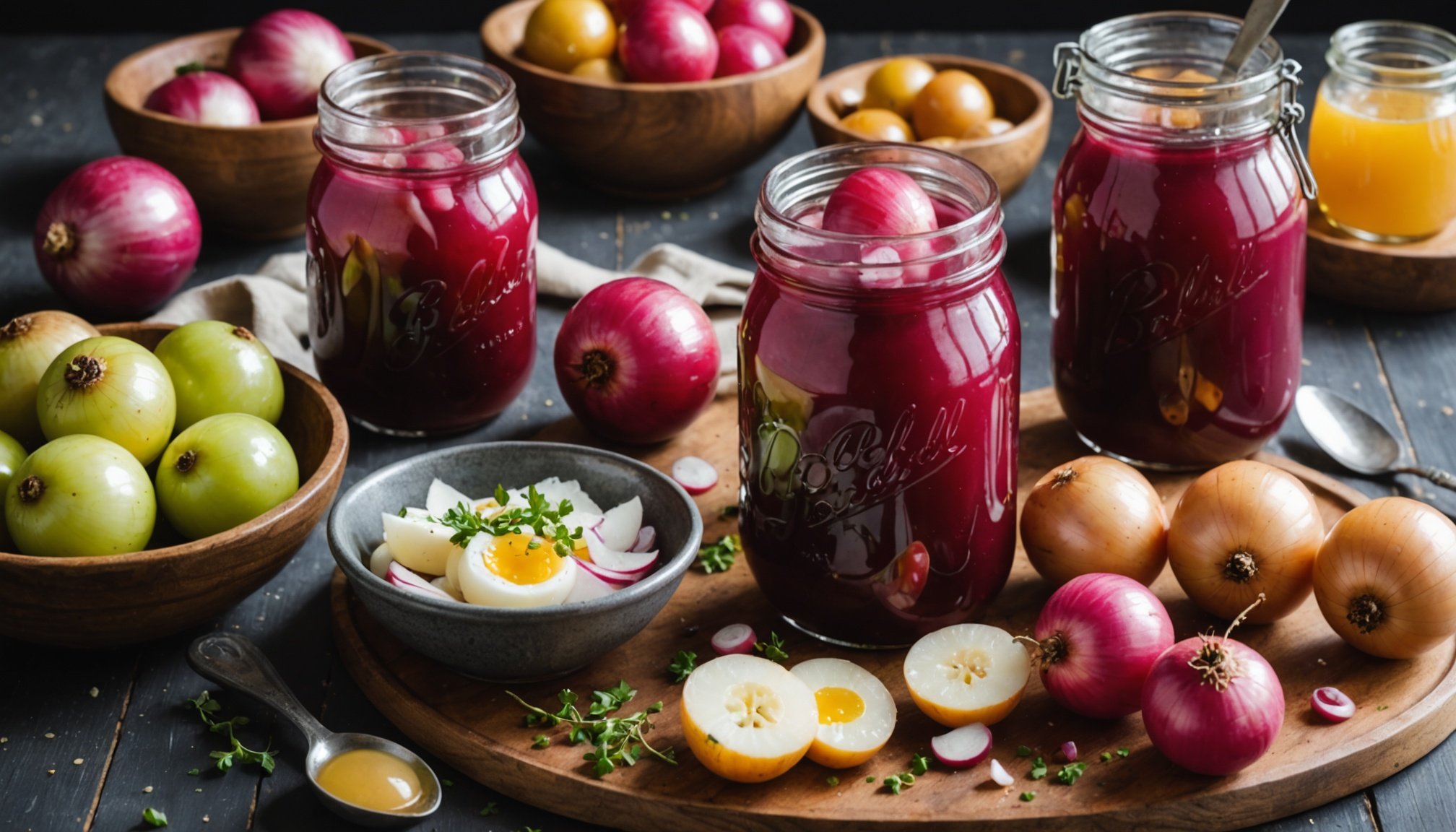Introduction to the Ploughman’s Lunch
The English Ploughman’s Lunch is a quintessential dish steeped in both tradition and practicality. Rooted in the history of rural Britain, this meal was designed to be hearty and satisfying, assembled with ingredients easily found in farmhouse pantries. It has come to symbolize the simplicity and resourcefulness of the English countryside.
History of Ploughman’s Lunch
Though it evokes a sense of ancient history, the recognisable “Ploughman’s Lunch” term began gaining popularity in the mid-20th century. Originally, it was a staple for labourers who needed a nourishing yet portable option to sustain them through long hours in the fields. The rise in pubs serving the dish in the 1960s further cemented its place in British cuisine.
Also read : Crafting the Perfect Traditional English Black Pudding: A Delectable Adventure with Oats and Aromatic Spices
Traditional Components
A typical Ploughman’s Lunch consists of a variety of simple but robust components:
- Thick slices of crusty bread, providing a solid base,
- A sharp cheese, like cheddar or stilton, adding a rich tang,
- Crisp pickled onions, offering a punchy contrast,
- Optional extras might include ham, chutney, apples, or a small salad, ensuring every element of savoury, sweet, and tart is represented, crafting a balanced meal fit for a ploughman.
Importance of Pickled Onions in the Ploughman’s Lunch
Pickled onions hold a pivotal role in the ensemble of an English Ploughman’s Lunch, adding a burst of acidity and crunch. This essential component not only enhances the flavour profile but provides a refreshing contrast to the rich elements like cheese and bread. The tangy bite of these onions cuts through the fattiness and balances the meal’s taste spectrum.
In parallel : Unlock the Secrets of Authentic Irish Beef Stew: Expert Tips for a Flavor-Packed Guinness Delight
The sharp and crisp pickled onion is revered for its ability to awaken the palate. It introduces a vibrant pop that enriches each bite, making it indispensable. Variations in pickled onion recipes exist across regions, offering different taste experiences. In some areas, sweet pickling solutions mellow out the sharpness, while others prefer spice-infused brine for added heat.
Traditionally, the pickling process involves immersing onions in vinegar or brine, often seasoned with mustard seeds, bay leaves, or peppercorns. This method ensures the onions retain their bite, crucial for their textural contribution. Whether savoured on its own or paired, the pickled onion’s adaptability is matched by its consistent ability to elevate the Ploughman’s Lunch into a fulfilling and memorable dish.
Detailed Recipe for Flawless Pickled Onions
Pickled onions enrich any dish, especially the Ploughman’s Lunch, with their tangy bite and crunchy texture.
Classic Pickled Onion Recipe
A straightforward pickled onion recipe requires minimal ingredients: small onions, vinegar (malt, cider, or white), sugar, salt, and spices like mustard seeds or peppercorns.
Ingredients and Preparation Steps
- Onions: Choose firm, fresh small onions.
- Vinegar: Opt for your preferred vinegar—each lends a distinct taste profile.
- Spices: Experiment with mustard seeds, bay leaves, or chili flakes for added zest.
Steps:
- Peel onions and soak in brine overnight.
- Rinse, drain, and pack into sterilised jars.
- Boil vinegar with sugar and spices; pour over onions, leaving space at the top.
- Seal jars, let cool, and store in a dark place.
Tips for Perfecting the Pickling Process
Select high-quality onions for crisp texture. Equally, control the sugar and salt balance to avoid overt sweet or salty flavors. Uniform onion size ensures even pickling. Adapt recipes by adjusting spices for heat or sweetness. Be cautious about underboiling the vinegar solution, which might lead to inadequate preservation.
Assembling the Perfect Ploughman’s Lunch
Constructing the ultimate Ploughman’s Lunch involves a careful balance of flavours and textures. The dish traditionally thrives on its simplicity, embodying the essence of rustic and hearty dining. A standard arrangement would encompass a few core components: substantial crusty bread, a robust cheese such as mature cheddar, a sharp pickled onion, fresh salad and seasonal fruits like apple. Each element contributes to the flavor symphony essential to a classic Ploughman’s Lunch experience.
Ensuring a harmonious balance between soft and crunchy, creamy and acidic, is key. Incorporating extras like chutney or mustard creates complementary contrasts, elevating the meal further. Careful consideration of portion size and variation keeps each bite intriguing.
For added originality, consider creative serving ideas: a wooden board for a rustic charm, or individual buffet-style jars for modern flair at a picnic. This meal offers room for customisation, be it by substituting bread with crackers or including smoked meats. In essence, the Ploughman’s Lunch serves as a canvas to deliver both tradition and personal touch, making it appealing for diverse palates while honouring its cultural roots.
Variations of Pickled Onions
Exploring pickled onion variations can elevate the classic Ploughman’s Lunch to new taste horizons. Each variation provides a distinct flavour break from the traditional, offering unique profiles for the adventurous palate. Among the most popular are spicy, sweet, and herb-infused varieties, each delivering its unique twist to this beloved condiment.
Regional Pickling Techniques
In different areas, regional techniques influence pickling methods profoundly. For instance, spicy variants may incorporate chili flakes or whole peppers, adding a notable kick to every bite. Sweet pickled onions often favour sugars or honey, turning the typically tangy ingredient to a more dessert-like experience. Alternatively, herb-infused recipes employ dill or thyme for aromatic depth.
Creative Usage Suggestions
Beyond enhancing a Ploughman’s Lunch, think outside the box: consider incorporating these onions in tacos, burgers, or salads for crunch and complexity. Engage your guests with unexpected pairings, sparking conversations around the diverse applications and complexities of their flavours. Whether spicy, sweet, or herb-infused, the versatility and adaptability of pickled onions ensure they remain a favourite and flexible component across a spectrum of dishes.
Pairing Suggestions for a Ploughman’s Lunch
When crafting a Ploughman’s Lunch, selecting apt pairings enhances the meal’s enjoyment and balances flavours. A well-chosen cheese and bread serve as cornerstones. Opt for mature cheddar’s robust nature or crumbly stilton for a fuller depth, paired with crusty sourdough or wholemeal bread for contrasting textures.
The beverages of choice range according to preference. A traditional British ale brings out the savouriness in the cheese, while a crisp cider provides a refreshing contrast to the hearty components. White wine, particularly a Chenin Blanc, pairs beautifully with the creamy aspects, offering a touch of acidity to cleanse the palate. Non-alcoholic options like sparkling water or a light herbal tea can also be delightful in cutting the richness of the lunch.
To further complement the Ploughman’s Lunch, consider adding sides such as a zesty coleslaw or tangy pickles. These not only infuse extra textures but also diversify the tasting experience. Assembling an array of accompaniments ensures a versatile and gratifying meal, turning each bite into a unique flavour journey that honours the simplicity and tradition of this classic dish.
Regional Differences in Ploughman’s Lunch
The English Ploughman’s Lunch manifests distinct characteristics across the UK, reflecting each region’s culinary traditions. Local ingredients and practices shape these dishes, offering unique taste experiences. For instance, in the West Country, where cheese production is prevalent, you might encounter local favourites like Somerset Brie or Red Leicester playing the starring role, providing regional authenticity.
Northern areas, known for their hearty fare, often include a slice of pork pie alongside traditional elements, adding substantial richness. Similarly, in coastal regions, you might find seafood elements like smoked mackerel integrated into the lunch, illustrating the influence of geographical location on the dish’s makeup.
Regional favourites can also include variations in bread selection; for example, in Yorkshire, a denser, wholemeal loaf might be preferred, while the South may favour lighter, ciabatta-like options. These differences not only offer diversity but also reflect local agricultural practices and historical influences.
Understanding these regional variations enriches appreciation for the Ploughman’s Lunch, linking diners to the wider cultural landscape of the British Isles. Each locale brings a distinct nuance to this meal, weaving a tapestry of flavours that respects the heritage and spirit of its origins.
Serving Ideas and Presentation
Plating an English Ploughman’s Lunch can make a significant difference in the meal’s appeal. For a traditional presentation, use a rustic wooden board. This setup enhances the authenticity and provides a sturdy surface for a variety of components. For a more contemporary twist, consider using individual slate tiles or small charcuterie boards for guests, enhancing the sense of personalisation.
When styling the components, ensure each element is visible and accessible. Place the thick slices of crusty bread at one end, with slices overlapping. Position the sharp cheese next to it, possibly in a tower or spiral form. The pickled onions can be contained in a small ramekin to avoid vinegar spillage. Include apple slices and ham diagonally across, interspersed with chutney or a small salad. This layout ensures a balance between portability and aesthetic appeal.
For thematic events like picnics, serve in mason jars, layering each item. This not only maintains freshness but also adds a portable element to the meal. Play with colour contrasts—using vibrant greens and reds—ensuring the presentation is as delightful as the Ploughman’s Lunch itself.



